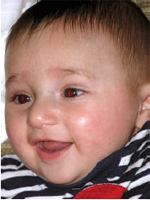Seeing Red
 Description: Teacher demonstration
Description: Teacher demonstration
Purpose: Students will analyze photographs to see red eye and locate the retina
Length of Activity: 15 minutes
Materials: Ask students to bring in pictures from home of themselves, family or friends with red eye.
Further Suggestion: During this activity students may bring in photographs of animals wondering why their eyes glow white or yellow instead of red. Some animals have a special reflector in the backs of their eyes that double the amount of light their eyes can use. This reflector is called a tapetum and it lies in front of their retinas. When you see an animal at night or if you take a flash photograph it looks like its eyes glow, but what you’re really seeing is the tapetum reflecting light. Animals with tapetums include dogs, cats, raccoons, cows, sharks, deer and moths.
Steps:
1. Distribute photographs to all students that demonstrate red eye.
2. Ask where the red is located (in the pupil).
3. Remind students that the pupil is clear. Then ask what is on the other side (the retina).
4. Ask why the retina appears red (the layer of blood vessels in the retina make it red).
What’s Going On?
Have you ever seen a picture where a person’s pupils looked red? Did you know that you were looking at their retinas? In low light our pupils get larger or dilated to help our rods gather more light. If you take a picture with flash when a person’s pupils are dilated, the flash will bounce off the back of their eyes or retina. Human retinas are red due to the layer of blood vessels there - hence it looks like the person has red eyes. Many modern cameras reduce the possibility of red eye by having the flash go off twice. The first time is to cause the eye’s pupil to contract; the second time is to take the picture.